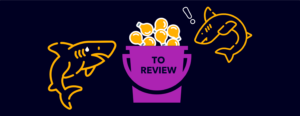If there would be an award for “most popular innovation advice”, the phrase “think outside the box” might just take home the prize. Unfortunately, this phrase might be one of the most misleading innovation advices out there. Why? Simply because in most of the cases there is no box. As a result, thinking outside the box is often interpreted as welcoming all ideas, without any constraints. While welcoming all ideas without constraints sounds like the best way to find innovative ideas, research shows that, actually, quite the opposite is true. Pursuing novelty without guidelines can overwhelm people with options, engender waste, and prevent the coordination required for innovation, especially Collaborative Innovation.
Researchers discovered that innovation is actually spurred by constraints. By setting the right scope and rules, people are given the right amount of guidance to feel comfortable and to think in relevant directions. Instead of trying to think outside the wrong box, you should instead set simple rules to draw the right box and innovate within it.
Contrary to popular myth, imagination and innovation are actually spurred by constraints. Too much freedom can be paralyzing.
John Seely Brown (USC Professor)
But how do you draw the right box? An easy way to get started is by only accepting ideas as a response to well-defined challenges. Ideally these challenges are defined by the management and other stakeholders.
While every company’s innovation focus is different, we’ve found some innovation topics that can be almost always part of your Collaborative Innovation program. We’ve listed some of them below, together with what you’ll actually achieve with them.
Drawing the Right Box
We have grouped the different topics based on what types of ideas you are looking for. Are you looking for incremental ideas or are we talking business here? Maybe you are just looking for another way to boost employee engagement. Depending on what you want to achieve you will be drawing a different box, where people can think inside of, but definitely outside. Only this time, it will be a box that is in accordance with the company’s expectations.
#1: Accessible Innovation Topics
Why would you launch an accessible innovation topic?
You must be wondering why you would go for small ideas, if all you hear is that you need to move faster. Here are a few arguments – but absolutely not the only ones – why you should collect small ideas.
- Launch: You are (re-)launching your Collaborative Innovation program. Aiming for small ideas will make innovation accessible in your organization and increase the participation rate. You will create momentum and show that ideas are being supported. This will help you to establish a culture of innovation. In such organizational culture the big ideas will follow more naturally.
- Boost: If a boost in employee engagement is what you are looking for it is recommended to open some accessible innovation topics and invite as many people as possible to participate. Giving people the opportunity to participate in innovation has proven to be a true employee engagement booster.
- Trends: Incremental innovation topics offer also a great opportunity to identify trends. A call for incremental ideas is an ideal way to for example learn what’s on the minds of your participants and what lives inside or outside your organization, depending on who you decide to involve of course.
- Disrupt: Another motivation to launch such a topic is that you are simply looking for continuous improvement and quick wins, which is, contrary to popular belief, a great approach to foster real progress. We often encounter organizations that are desperately in search for the next big idea. One could argue that this is actually a dangerous mindset. The pursuit for disruption could actually be the cause of it.
How do you recognize an accessible innovation topic?
Below we have listed some of the most distinct characteristics of innovation topics that call for small ideas.
- The topic is easy to understand.
- Many ideas are expected to be shared.
- Ideas are small, also often referred to as Incremental Ideas.
- The biggest value of ideas lies in:
- Saving Time/Money
- Efficiency & Process improvements
- Product improvements
- Workplace improvements (safety, fun factor, communication,…)
- Everybody can contribute / The topic is not aimed at a specific target group or organizational layer.
- Information needed to qualify an idea is limited.
- The barrier for submission is low (a simple idea form).
- The process followed by ideas is rather short and straightforward.
- Ideas are low risk and easy to implement.
- The topic aims at improving your situation today (for your customers, employees, …)
Examples of accessible innovation topics
To make it easy for you we have listed some common topics to call for small ideas and involve as much people as possible in your efforts for continuous progress.
- How can we become the best place to work?
- How can we save money in creative ways?
- How can we improve employer branding (inside/outside)?
- How can we (re-)connect our employees?
- Recently I encountered a nice idea related to this topic: “Escape Room for Microsoft Teams”. (Yes, you can have that idea!) But I am sure that there are many more ideas to discover amongst your own colleagues!
- How can we reduce our carbon footprint?
- How can we increase safety @ work?
All of the above topics match at least with three of the previously mentioned criteria which qualifies them as great engagement boosters and incremental idea explorers.
#2: Expert Innovation Topics
Why do you launch Expert Innovation Topics?
Apart from the small ideas, you might also want to pursue some bigger ideas, often referred to as the business ideas. I assume that the “why” might be more straightforward for these ideas. The number one reason to look for business ideas is – yes, say it – because you want to do more business. More business can mean a number of different things: more customers in your current market, a new type of customers, shifting your business model, you name it. In the end the goal remains the same: more revenue.
One other common expert innovation topic is the introduction of new, breakthrough technologies. The goal in the end is to adopt these technologies and to end up with more efficient operations or new offerings.
In the end the goal remains similar to straightforward business ideas: more money, either through a better profit ratio or by making additional revenue.
How do you recognize Expert Innovation Topics?
Expert innovation topics can be recognized by the following characteristics:
- You will limit the scope inside your own organization (e.g. by only involving a certain department or an expert group)
- You will invite external participants to help you in finding some out-of-the-right-box ideas
- The topic is harder to understand and requires a form of expertise:
- A good understanding of core business aspects
- Technological/Field expertise (e.g. engineering, information technology, …)
- These topics will focus directly on the revenue of the organizations (direct gain, rather than indirect gain).
- A lower amount of ideas is expected, but higher quality is demanded.
- The amount of information to qualify an idea is elaborated.
- The process that an idea will follow before it will be implemented is extensive.
- The process often involves the development of a PoC or prototype.
- The risk is higher.
- The topic aims at improving your situation in the long term.
Examples of Expert Innovation Topics
- What are new business models we could introduce with our existing portfolio?
- Which ideas would bring us into big trouble when implemented by a competitor?
- Which startup should we launch next to our core business?
- What sustainable business model could we launch? (Circular economy, Sharing economy, Solution economy)
- How can we gain new revenue/additional revenue with existing products/services?
- How can we leverage advanced visualization technologies?
- How can we harness the power of AI in our existing products?
As you may have noticed, the proposed examples also include a focus on existing things in the organization, which allows for true quick wins to be discovered with yet a big impact on the outcome. Sometimes we just don’t see what’s right under our noses. Absolutely, we need to think big and dare to dream even bigger, but we shouldn’t underestimate the power of incremental (revenue) improvements!
#3: The “Moonshot” Question
We never told you that you shouldn’t accept ideas that don’t belong to any box. But it’s never a good idea to offer it as the only option. Because of the earlier mentioned paralysing effect, it can even hardly be called an option. A topic that allows all – including crazy – ideas is often being referred to as the “Moonshot” topic.

We didn’t land on the moon because it would be nice. In 1962 President Kennedy gave a speech which contained the words “We choose to go to the moon this decade”. He didn’t say how, he didn’t say it would be easy. He just set the time frame and provided inspiration. That is exactly what you should do too, dare to think big and invite others to think even bigger!
That’s why we recommend to have a Moonshot-challenge that is accessible by anyone, next to your more incremental innovation topics. Maybe Neal will take a small step and share that brilliant idea where you never thought about. All you need next is daring to to take that (giant) leap.
⚠️ Caution: Handle with care
Since I want to give you the best advice, I also consider it my duty to warn you for the pitfalls of such a moonshot challenge. Aiming for the moon is just dumb if nobody can build a vessel to actually get there. Therefore:
- Only launch a Moonshot if you are truly open to execute crazy or big ideas. You should have a strategy and/or resources in place in case you receive such an idea.
- Provide time and coaching to elaborate on the idea in the next steps of the process.
- Be transparent on the expectations:
- What is the value an idea should bring to the company and how will this be measured?
- How will ideas be evaluated?
- How will be resources be assigned?
- What needs to be delivered as a POC?
- …
- Don’t be a “groupie” – Don’t always say yes because you are reviewing ideas early in the process and somebody else will kill it later. This sets the wrong expectations. If an idea is not good:
- Try to pivot it.
- If that doesn’t work: Kill it and motivate why.
- Don’t kill ideas too fast and when you do, leave room for discussion. The most brilliant ideas live and grow inside people’s minds. It’s YOUR JOB to get it out there.
- Give constructive feedback and invite others to challenge the moonshot ideas. Open the discussion to hear all voices and build a better rocket 🚀
Didn’t find what you were looking for?
Maybe you already have launched one or more of these campaigns or maybe you are unsure whether these topics actually fit your organization and workforce. Finding the right topic that inspires a large group of people isn’t always easy and one size definitely doesn’t fit all. If that is the case we invite you to read our other blog post on how you can find them and have them at your disposal when you need them.
Final Thoughts
Innovation Topics and ideas related to those topics can be categorized in many different ways. Maybe you see those topics differently and that’s okay 🙂 The most important takeaway is that you need them to prevent creative paralysis. Working with different topics in combination with a transparent process for all of them allows you to manage expectations, prevent waste and foster creativity. Which topics you choose to focus on and when you launch them is entirely up to you. In the end it is as with most things in life: It is about balance.


